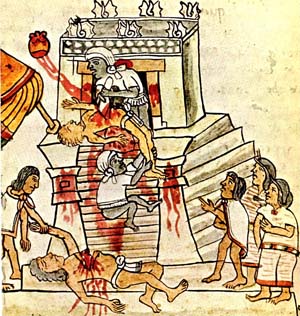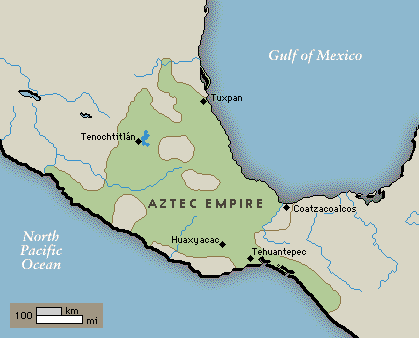|
Aztec
The Aztecs migrated to the central valley of Mexico from a more northern part of Mexico around 1200 AD, after the collapse of the Toltec civilization (Aztec ancestors?). The Toltec civilization lasted from 400AD to 1200AD in central Mexico, though there is a debate as to whether the Toltecs should be conferred with the status of a civilization. In any case a calamity of some description befell the people in this area, perhaps instigated by invaders from the north, or a localised drought. So the migrants took refuge on an island in Lake Texcoco and began building a city which was to become their capital, called Tenochtitlan, on the present day site of Mexico city.
They built up their island city into an impregnable fortress, interlaced with canals used for transportation and used causeways to connect to the shoreline.
Tenochtitlan

|
They quickly began to expand their territory and conquer their neighbors, building up great wealth from their conquests. Tenochtitlan was turned into a city of palaces, temples (to worship their many Gods), pyramids , marketplaces and floating gardens to feed the inhabitants - probably about 400,000 to 500,000 at its height including its suburbs. Accounts from Cortes record 78 major structures in Tenochtitlan including The Great Pyramid which was the main temple of the Aztecs and rose to an impressive height of 60m. Tenochtitlan was a huge metropolis, constructed over artifical islands with a temple district at its heart, surrounded by royal palaces and residential areas.
The Aztecs were known for their architecture, jewellery, sculptures and textiles. Skilled artists created stone sculptures, ceramic statutes, mosaics and story-telling murals. Their writing was a combination of hieroglyphs and pictographs and in this way they left accounts of their lives and history. Religion, worship and sacrifice played a major role in Aztec life. And priests were considered to be very important people.
They worshipped many Gods including the feathered serpent, Quetzalcoatl, possibly inherited from the Toltecs. Religious rituals included human sacrifice on a large scale using either war captives or their own people. Cutting the hearts out of the bodies of live victims with obsidian knives was a common practice.
Human Sacrifice

|
This was meant to pay homage to the gods and keep the world in balance. They worshipped the sun as a god. They believed the sun fought the darkness. If they fed the sun blood each day it would win the nightly battle against the darkness and rise again.
The Aztecs believed in an afterlife (where did this idea originate from?). And it was how they died rather than how they lived that they thought determined whether they would go to the sun god or to the dark and dismal underworld. Fighting in battle was considered a duty and an honour. It was seen by Aztec warriors as a time to show their skills, something they had trained for since their early life.
Warriors who died in battle would go straight to the sun god. The Aztecs waged war almost incessantly, often just to obtain captives for human sacrifice. Mass sacrifices were common place. In one instance, to celebrate completion of the work on the Great Temple (Templo Mayor), a four-day celebration was planned and about 20,000 captives were sacrificed!
Ritualised slaughter of humans seemed to be a theme for all the great civilizations in Mesoamerica and South America, but the Aztecs seemed to take it to a new level in terms of the numbers slaughtered.
The Aztecs did build an impressive empire albeit one of the most warlike and cruel. By 1500 estimates put the population of the empire at 15 million people, spread over vast areas. But they were conquered by the Spanish invaders under Cortes 1519 - 1521. They were no match for the battle tactics, firearms, canons, iron swords and horse soldiers of the Spanish. They only had spears, slings and bows. Not to mention that Cortes had numerous allies to rely on from within the Aztec empire as they were also on the point of revolting, after years of hardship and working to supply Tenochtitlan and the Aztec empire with food, animals, slaves and people for sacrifice. So Cortes found it relatively easy to convince many of the various factions to be allies.
The Aztec Empire

|
The victorious Spaniards, in their quest for gold and glory, demolished most of the city of Tenochtitlan, they introduced Christianity - replacing the native cults. They (unintentionally) introduced lethal contagious diseases including smallpox, measles and typhus which the indigenous people had no immunity to. This accompanied with the forced labour of the conquered locals contributed greatly to the decline of the Aztec population.
|

